Hunting Billbug, Sphenophorus venatus vestitus Chittenden (Insecta: Coleoptera: Curculionidae)
Introduction
The Featured Creatures collection provides in-depth profiles of insects, nematodes, arachnids and other organisms relevant to Florida. These profiles are intended for the use of interested laypersons with some knowledge of biology as well as academic audiences.
The hunting billbug, Sphenophorus venatus vestitus Chittenden, is a weevil that is also commonly known as the "zoysia billbug" in Florida, where it has been reported as a pest of various grasses, especially in nurseries. Billbug larva are often confused with white grubs, which is the name usually given to beetle larvae in the genus Phyllophaga, family Scarabaeidae.
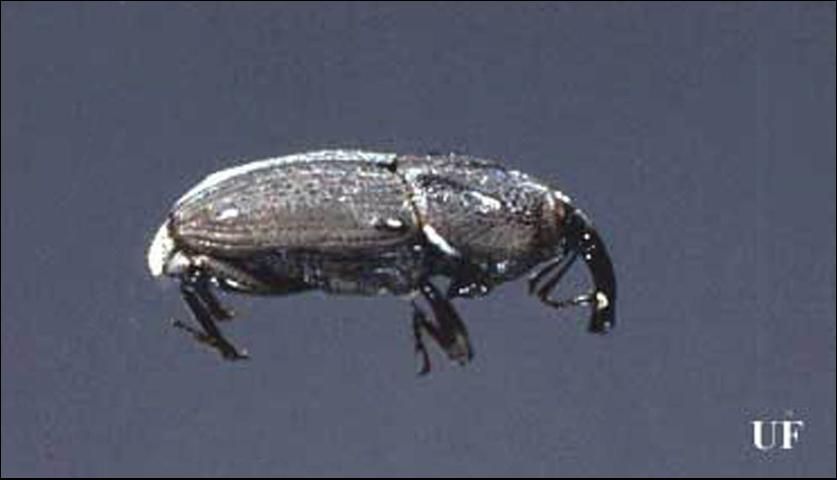
Credit: University of Florida
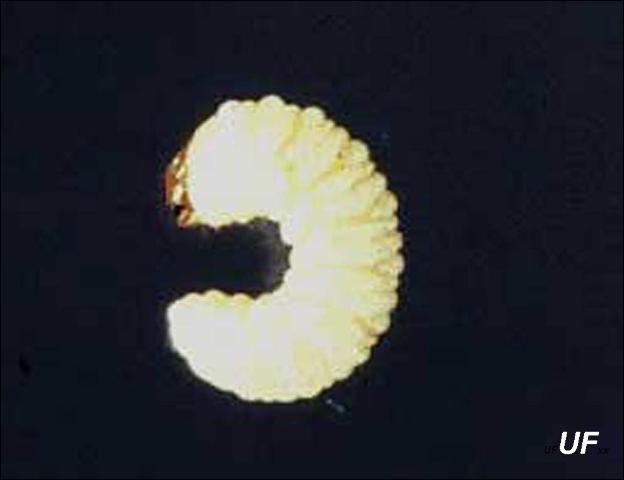
Credit: University of Florida
Taxonomy
The genus Sphenophorus contains 64 species in the United States, with 20 of these being recorded from Florida (Vaurie 1951). Sphenophorus venatus (Say) has been divided into five subspecies, of which only one (vestitus Chitt.) is found in the southeast. This genus was previously called Calandra and Calendra, but these names have been suppressed in favor of Sphenophorus by the International Commission on Zoological Nomenclature (1959). Specimens of this group are often difficult to identify and should be sent to a specialist for confirmation.
Distribution
Vaurie (1951) records the hunting billbug from Alabama, Arkansas, District of Columbia, Florida, Georgia, Kansas, Louisiana, Mississippi, Missouri, North Carolina, South Carolina, Texas and Virginia, as well as the Bahamas, Cuba, Dominican Republic, and Puerto Rico.
Description
Adult
The adult is 6 to 11 mm in length. It is typically weevil-like in appearance with a short, fairly broad, recurved snout. The color is variable from gray to black with reddish or brown areas sometimes visible. The body surface is often coated with soil as well as a naturally pruinose, clayey coating, giving the weevil a dirty appearance. Specimens are also susceptible to greasing from body oils. These two conditions are responsible for considerable variation in appearance. The pronotum is coarsely punctate except for a "Y"-shaped area in the center and a parenthesis-like marking on each side. This pattern is characteristic of the species.
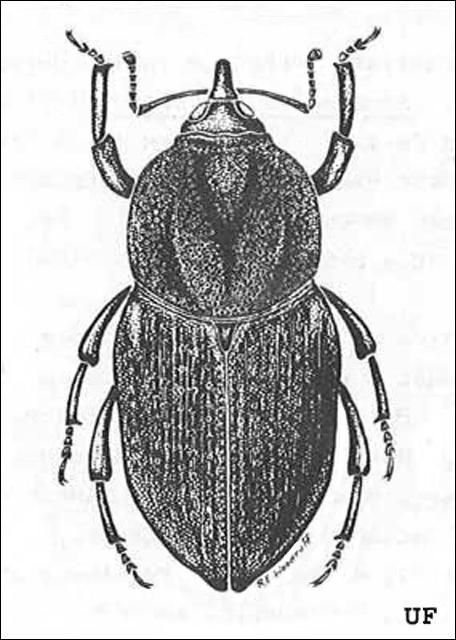
Credit: University of Florida
Larva
The larva is typical of most weevil larvae, being thickest at the middle. The body is white to yellowish, the head tan to brown and mandibles mostly black.
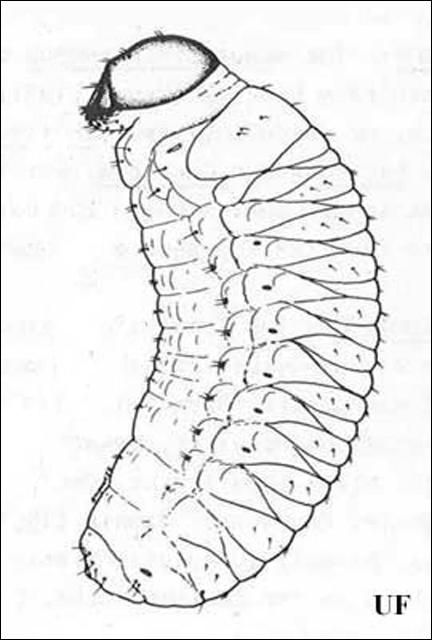
Credit: University of Florida
Biology
Most of the details of the life history are not known. According to Kelsheimer (1956), the eggs are laid in the leaf sheaths or top of the crown; they hatch in three to ten days, and the newly emerged larvae feed on the inner leaves as they work their way to the roots. Larvae have been found at depths of eight inches, and although as many as 72 per square foot were reported, the average find was 10 to 14. Pupation in the soil or in the roots occurs after three to five weeks. The pupal period was noted as three to seven days. Adults have been found every month of the year, but most activity has been noted in the fall and winter.
Hosts
Nearly all the members of this genus feed on grasses and sedges. Most of the damage results when lawn grasses are planted in areas which formerly had high populations on natural grass and sedge cover. This seems to be particularly true in moist areas such as the muckland around Lake Okeechobee which is used for commercial sod production.
By far, the most commonly recorded host in Florida is zoysiagrass (Zoysia matrella (L.) Merr.) and Bermudagrass (Cynodon dactylon (L.) Pers.). Other hosts recorded in Florida are: Pensacola Bahiagrass (Paspalum notatum Flugge), St. Augustinegrass (Stenotaphrum secundatum (Walt. Kunze), centipedegrass (Eremochloa ophiuroides (Munro) Hack.), corn (Zea mays L.), sugarcane (Saccharum officinarum L.) and leather-leaf fern (Polystichum adiantiforme J. Smith). Satterthwait (1931) listed hosts for S. venatus, some of which might apply to S. vestitus: yellow nut grass (Cyperus esculentus L.), wheat (Triticum aestivum L.), timothy (Phleum pratense L.), and a bulrush (Scirpus validus Vahl.).
Economic Importance
Historically, hunting billbug was not a major turf pest in Florida (Kerr 1964), but billbugs seem to be increasing in importance. The damage is most serious on the roots, but young larvae apparently cause some leaf or shoot damage. Kelsheimer (1956) noted that the damage caused problems in handling the cut sod squares for shipment. The root system is often so weakened that the squares will not hold together.
Damage usually first appears as yellow spots only a few inches in diameter, but these spots will gradually become larger as feeding continues. Heavy infestations completely destroy the roots, and the grass can be rolled back like a carpet. Moles, skunks, and armadillos feed on the grubs and may damage the lawn searching for them.
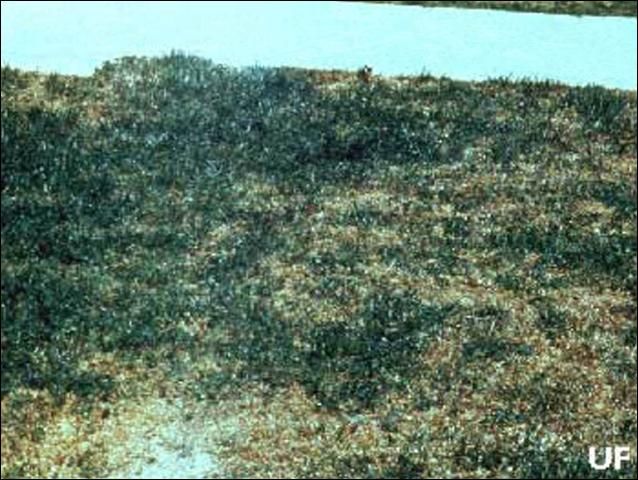
Credit: University of Florida
To inspect for billbugs or grubs, cut three sides of a one foot square piece of sod about two inches deep with a spade under the sod and lay it back. See if the grass roots are chewed off and sift through the soil to determine if larvae are present. Replace the strip of sod. Inspect several areas in the lawn. As a rule of thumb, if an average of ten billbugs is found per square foot, apply an insecticide.
Management
If necessary, several insecticides are successful in controlling this pest.
For more information, please see: Insect Pest Management on Turfgrass.
Selected References
Blatchley WS, Leng CW. 1916. Rhynchophora or Weevils of North Eastern America. Nature Publishing Co., Indianapolis, IN. 682 p.
Fasulo TR, Kern W, Koehler PG, Short DE. (2005). Pests In and Around the Home. Version 2.0. UF/IFAS CD-ROM. SW 126.
International Commission on Zoological Nomenclature. 1959. Bull. Zool. Nomenclature 17: 112–116.
Kelsheimer EG. 1956. The hunting billbug, a serious pest of zoysia. Proceedings of the Florida State Horticultural Society 69: 415–418.
Kerr SH. 1964. Control of hunting billbugs. Florida Entomologist 47: 269–270.
Kissinger DG. 1964. Curculionidae of America North of Mexico, a Key to the Genera. Taxonomic Publications, South Lancaster, PA. 143 p.
Satterthwait AF. 1931. Key to known pupae of the genus Calendra, with host-plant and distribution notes. Annals of the Entomological Society of America 24: 143–172.
Vaurie P. 1951. Revision of the genus Calendra (formerly Sphenophorus) in the United States and Mexico (Coleoptera: Curculionidae). Bulletin of the American Museum of Natural History 98: 33–186.



